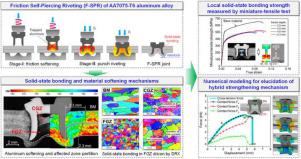Journal of Materials Science & Technology ( IF 11.2 ) Pub Date : 2021-09-20 , DOI: 10.1016/j.jmst.2021.07.026 Yunwu Ma 1, 2 , Bingxin Yang 1, 3 , Shanqing Hu 1, 3 , He Shan 1, 3 , Peihao Geng 2 , Yongbing Li 1, 3 , Ninshu Ma 2

|
A recently developed friction self-piercing riveting (F-SPR) technique based on the combination of friction stir processing and riveting has been reported to possess both solid-state bonding and mechanical fastening characteristics. However, there is still a lack of quantitative understanding of the hybrid enhancement mechanism, hindering its engineering application. To fill in this gap, the current research investigated the microstructure evolution, microhardness distribution, and miniature-tensile performance of the aluminum alloy AA7075-T6 F-SPR joints by experiments. An accurate numerical simulation model was established to quantitatively evaluate the individual contributions of microstructure, local bonding strength, and macro interlocking to the performance of the joint, which could well explain the experimental results. It was found that due to the friction stirring of the rivet, solid-state bonding driven by dynamic recrystallization is realized between the trapped aluminum in the rivet cavity and the bottom aluminum sheet. The solid-state bonding zone has 75% yield strength, 81% ultimate tensile strength, and 106% elongation compared to the base material. This solid-state bonding enables the internal interlocking between the trapped aluminum and the rivet to withstand the additional load, which forms a novel dual-interlock fastening mechanism and increases the peak cross-tension force by 14.3% compared to the single-interlock joint.
中文翻译:

AA7075-T6铝合金摩擦自冲铆接接头固相结合与机械互锁联合强化机制
据报道,最近开发的基于搅拌摩擦加工和铆接相结合的摩擦自冲铆接 (F-SPR) 技术具有固态结合和机械紧固特性。然而,目前对混合增强机制还缺乏定量的理解,阻碍了其工程应用。为了填补这一空白,目前的研究通过实验研究了铝合金AA7075-T6 F-SPR接头的微观结构演变、显微硬度分布和微型拉伸性能。建立了精确的数值模拟模型,定量评估了微观结构、局部结合强度和宏观互锁对接头性能的个体贡献,可以很好地解释实验结果。研究发现,由于铆钉的摩擦搅拌,在铆钉腔内的被困铝与底部铝板之间实现了动态再结晶驱动的固态结合。与基材相比,固态结合区具有 75% 的屈服强度、81% 的极限拉伸强度和 106% 的伸长率。这种固态结合使被困铝和铆钉之间的内部互锁能够承受额外的负载,形成一种新颖的双互锁紧固机制,与单互锁接头相比,峰值横向张力增加了14.3%。与基材相比,固态结合区具有 75% 的屈服强度、81% 的极限拉伸强度和 106% 的伸长率。这种固态结合使被困铝和铆钉之间的内部互锁能够承受额外的负载,形成一种新颖的双互锁紧固机制,与单互锁接头相比,峰值横向张力增加了14.3%。与基材相比,固态结合区具有 75% 的屈服强度、81% 的极限拉伸强度和 106% 的伸长率。这种固态结合使被困铝和铆钉之间的内部互锁能够承受额外的负载,形成一种新颖的双互锁紧固机制,与单互锁接头相比,峰值横向张力增加了14.3%。











































 京公网安备 11010802027423号
京公网安备 11010802027423号